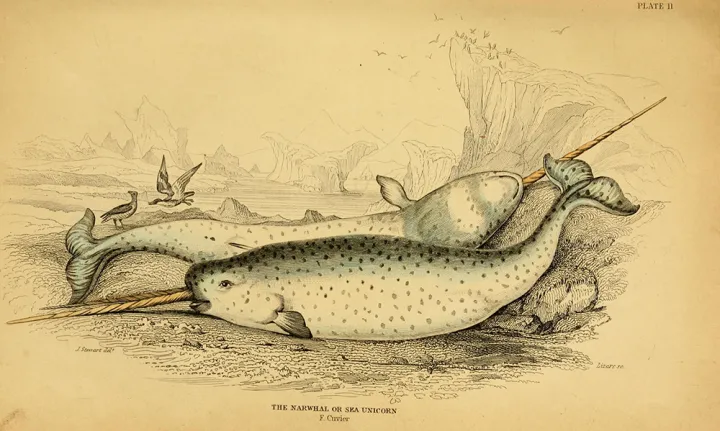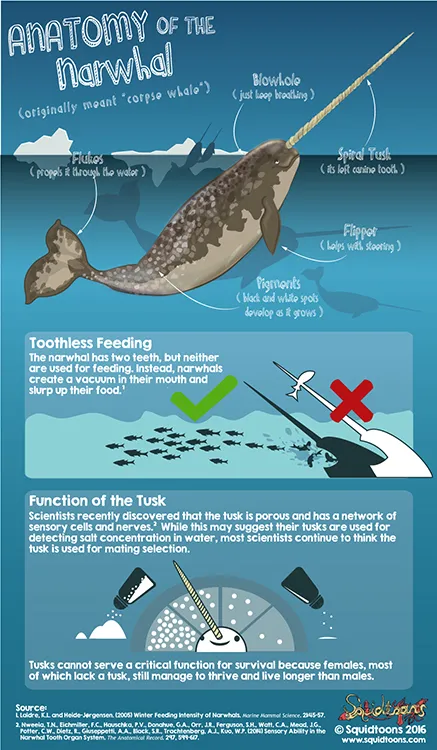Why a Tusk? The real-life unicorns of the sea and the tusks that make them famous

In the frigid Arctic Ocean, a mysterious toothed whale—the narwhal— resides among the ice floes. Although some evidence suggests it’s the source of fantastical tales about unicorns, the narwhal is, in fact, a living, breathing mammal. There are roughly 172,000 of them swimming in the ocean today. But because narwhals live in such an isolated and treacherous region of the world, there is still much we don’t know about them.
The narwhal tusk—the unique, spiraled tooth that protrudes out of the upper lip— is a source of debate and discussion. Tales of tusks being used for breaking ice, spearing fish, and digging along the seabed were once considered plausible explanations. But by piecing together observations of the narwhal’s anatomy and behavior, combined with clues from other closely related animals, such as the beluga, several promising ideas emerge.
Tusks of attraction
To begin, not all narwhals have tusks, and a few, including one on display at the Sant Ocean Hall, have two. They are noticeably absent in most females—a mere 15 percent of females have an elongated tusk-like the males.If tusks are mostly a male characteristic, then perhaps wielding a longer, stronger tusk has an advantage for finding a mate.
Charles Darwin included this idea in his theory of evolution. The basis of Darwin’s theory is natural selection; the evolutionarily “fittest” individuals will survive long enough to pass on their better-adapted traits to future generations. But certain animals threw a wrench in this theory—think of the elaborate coloration of the male peacock and the cumbersome antlers of a moose. Both are energetically costly to develop and a liability for escaping hungry and cunning predators. So why would a peacock display flashy feathers if it only increases the chances he will be eaten?
Darwin wrote about this as well. It all comes back to genes. Female peacocks love a male with an especially bright set of feathers. It tells her that he may be especially fit and better able to avoid being eaten even with the extra adornment. As a consequence, any offspring they have may also be especially healthy with a strong set of genes. The same applies for the moose. The larger the antler rack, the better they can fight off other competitive males for exclusive access to a female, a characteristic that can be passed on to male offspring. This is called sexual selection and is based on the idea that certain traits increase an animal’s ability to find a mate. In some cases, like moose, males compete directly with one another for access to a female, and in other cases, like peacocks, males compete indirectly by trying to be the most attractive to a choosy female.
Since the erupted narwhal tusk is typically a male trait, scientists believe it is very likely to be influenced by the process of sexual selection. One study found that the longer a narwhal’s tusk, the larger the size of the male’s testes, an indication that the tusk is tied to reproductive fitness. Also, scientists Helen Silverman and M.J. Dunbar found that male narwhals had a greater number of broken tusks and scars on their foreheads than females, suggesting they participate in aggressive battles over females. A few male narwhals even had tusk bits embedded in their jaw, possibly remnants of past battles.
And yet, no one has ever observed an aggressive encounter. Even the Inuit, indigenous Canadians with a rich knowledge of the Arctic and who rely on narwhals as a source of food, have never seen such a display. It may just be that humans haven’t seen it yet. In frigid winter months, narwhals live offshore under thick ice, making it nearly impossible to observe them between February and May (when scientists believe they breed). In summer months, when narwhals migrate toward the shore, it’s quite common to see two males crossing tusks—their heads pointed to the sky. It’s been suggested that this behavior is a way for young males to practice and size each other up before mating season.
A tool for survival
While some scientists argue the tusk’s purpose is to express superior masculinity, others point to recent research that shows a tusk may have another use.
A tusk is actually part of a set teeth: one stays embedded in the upper jaw, while the other grows into the spiraled tusk, sometimes more than 8 feet (2.4 meters) long. Like human teeth, the tusk has many sensory nerve endings that can detect subtleties in temperature, pressure, and particle presence in the water. But a narwhal tusk is a unique tooth in that the nerve system of the inner core connects directly to the outside of the tusk—no other animal’s tooth is like it. It’s estimated that 10 million fluid-filled channels, called tubules, cover the tusk from base to tip. They create a direct link from the narwhal nervous system to the outside world. In the teeth of other animals, the tubules abruptly end in the layer before the outermost enamel covering.
To figure out why the narwhal evolved such a unique sensory tool, scientists turn to clues from the environment. Some researchers believe tusks might help the whales survive the harsh and ever-changing conditions in the Arctic. Freezing temperatures and shifting ice floes can occur unexpectedly, covering the few breathing holes narwhals rely on to survive. When the weather shifts quickly, narwhals can die from exhaustion and starvation. In 1915, the largest entrapment on record killed more than 1,000 narwhals at once. Living in such a hazardous place, it would be highly beneficial for narwhals to have a way of predicting when ice shifts will occur.
That’s where the tusk comes into play. One study found that the sensory capabilities of the tusk may be strong enough to detect changes in the ocean salt concentration. Ocean saltiness is related to sea ice cover—as ocean water freezes salt gets left behind in the surrounding water. Perhaps a narwhal uses its tusk to check the weather forecast and then steer clear of the colder and saltier water.
Scientists are still puzzled by the discovery of the unique tusk anatomy. If tusks are important tools for surviving icy environments it begs the question—why don’t all females have a tusk? Scientists only just discovered the sensory capabilities in 2014, so for now, we can only speculate. Perhaps the tusk is used to locate females in heat by pinpointing hormones levels in the water. Or, perhaps, the sensory capability is a newly evolved trait that emerged after the tusk became a male-only trait.
Although it’s been tough to make definitive claims about the tusk’s function, new technology may help us unravel the mystery that has confounded scientists for so long. A recent drone video shows a group of particularly handy narwhals using their tusks to stun fish with a quick strike before eating them. The discovery was quite a surprise to scientists who were using the drones to estimate current narwhal populations. More research is needed to tease out how this discovery fits in with the larger picture of tusk evolution.
It’s unusual for scientists to be so puzzled by the function of something that is so conspicuous. In fact, the tusk might be used in multiple ways involving both natural and sexual selection, as is the case for African elephants. While we may not have a complete answer to the tusk’s function, it’s exciting to think that a few mysteries of the ocean are still open for future explorers to solve.



